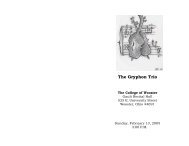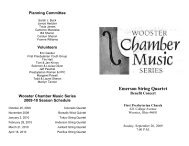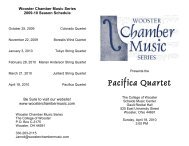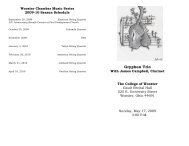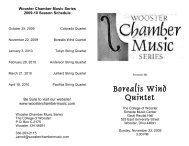colorado - small - Wooster Chamber Music Series
colorado - small - Wooster Chamber Music Series
colorado - small - Wooster Chamber Music Series
You also want an ePaper? Increase the reach of your titles
YUMPU automatically turns print PDFs into web optimized ePapers that Google loves.
ecorded in Sprague Hall at the Yale School of <strong>Music</strong>. They recorded<br />
during late night hours, in a (not always successful) attempt to<br />
lessen the likelihood of noisy interruptions from nearby street traffic.<br />
Another contemporary recording is their “Mosaic <strong>Chamber</strong> <strong>Music</strong> of<br />
Henry Cowell,” recorded in collaboration with the <strong>Music</strong>ians Accord<br />
ensemble.<br />
The Colorado Quartet is joined today by Carol Rodland on viola. Ms.<br />
Rodland made her solo debut with the Philadelphia Orchestra at age<br />
17, and went on to perform throughout North America and Europe.<br />
She has given solo recitals at Merkin Hall and Carnegie’s Weill<br />
Recital Hall, has played concertos with the Stuttgart <strong>Chamber</strong><br />
Orchestra and the Davos Festival Orchestra, has performed as guest<br />
violist with the Henschel Quartet throughout Europe, and has played<br />
frequently with both the Orpheus <strong>Chamber</strong> Orchestra and Vermont’s<br />
Craftsbury <strong>Chamber</strong> Players. Ms. Rodland won first prizes at the<br />
Washington International Competition, the Artists International<br />
Auditions, and the Juilliard Concerto Competition. She has been<br />
professor of viola at the New England Conservatory for two years.<br />
PROGRAM NOTES<br />
Written by Sarah J. Buck<br />
Ludwig van Beethoven (1770-1827)<br />
QUARTET IN A MINOR, OP. 132 (1825) – The monumental last<br />
quartets of Beethoven, the final major works he completed, provide<br />
much insight into the struggle of the composer to remain creatively<br />
active in the midst of the hardships fate had dealt him. In late 1824,<br />
Beethoven began to sketch the A minor quartet, the second of a set of<br />
three commissioned by Prince Galitzin. Work was interrupted,<br />
though, when he was struck with a severe and debilitating abdominal<br />
illness that winter. A period of rest and recuperation in the country<br />
allowed Beethoven to recover, and he was able to finish the work by<br />
July of the following year. The gravity of the sickness clearly left an<br />
impression on the composer; however it is not the pain of the illness<br />
which Beethoven chooses to depict in this piece, but the joy and<br />
thankfulness of his restored health.<br />
The opening of the first movement (Assai sostenuto–Allegro) derives<br />
from the simple, atmospheric landscape of the gentle beginning of the<br />
Ninth Symphony. A solitary rising half step in the cello provides the<br />
seed for a expanding texture in which the other three instruments<br />
quickly join in. As in the Ninth Symphony, though, we are swept<br />
into the movement proper without much delay. Though it proceeds<br />
as a well-behaved sonata-form movement is expected, we are<br />
frequently reminded of the half-step motive from the introductory<br />
passage. Following is a Scherzo (marked Allegro ma non tanto) that is<br />
more relaxed than Beethoven’s typical breakneck pace for such<br />
movements. The Trio section features a lilting melody with a drone<br />
that may remind the listener of a bagpipe tune.<br />
It is in the third movement that we are witness to the emotional<br />
backdrop of the piece. It is prefaced with the inscription Heiliger<br />
Dankgesang eines Genesenden an die Gottheit, in der lydischen Tonart<br />
(Holy song of thanks to God, in Lydian mode). The movement opens<br />
with a sober chorale using the Lydian scale (F major with B-natural<br />
instead of B-flat, using all white notes on the piano). Suddenly,<br />
though, the chorale breaks free, arriving in a spirited D-major<br />
passage. The chorale soon returns in a more rhythmically active<br />
form, again followed by the lively section. The chorale once again<br />
resurfaces. This time, however, it is transfigured, the upper voices<br />
reaching heavenward until the movement gradually fades away.<br />
There is no triumph here, no sense of accomplishment in cheating<br />
fate of its victim. Instead we find a pure statement of thanksgiving<br />
(sometimes prayerful, sometimes ebullient) for the delight of regained<br />
strength.<br />
Beethoven follows this centerpiece movement with a curious march<br />
(marked Assai vivace) whose regimented nature contrasts sharply<br />
with the previous movement. A transition leads us directly into the<br />
Finale, a rondo marked Allegro appasionado. Its straightforward<br />
character may be deliberate; after such trying times there may be<br />
comfort simply in returning to routine. The piece concludes in A<br />
major, confirming the resolution and restoration celebrated<br />
throughout the quartet.<br />
Wolfgang Amadeus Mozart (1756-1791)<br />
QUINTET IN C MAJOR, K. 515 (1787) – Mozart is easily eclipsed in<br />
the canon of Classical-era string quartets by Haydn, the original<br />
master of the genre. Mozart himself illustrated this through the<br />
famous set of six quartets written in homage to his elder<br />
contemporary. Not to be outdone, though, Mozart dabbled in<br />
variations on the traditional quartet instrumentation. For Mozart,<br />
this called for the addition of an extra viola, possibly because it was<br />
his favorite member of the string family (the more common quintet<br />
instrumentation doubled the cello instead). Five original works were<br />
composed for this quintet of two violins, two violas, and cello. The C<br />
major quintet, along with its companion piece (K. 516 in G minor)<br />
were composed in 1787.<br />
The surprisingly expansive opening Allegro commences with a<br />
delightful conversation between cello and violin. The cello begins<br />
with an arpeggiated C major chord, quickly followed by an answer in<br />
the violin. Soon, though, the instruments reverse roles and shift to C



